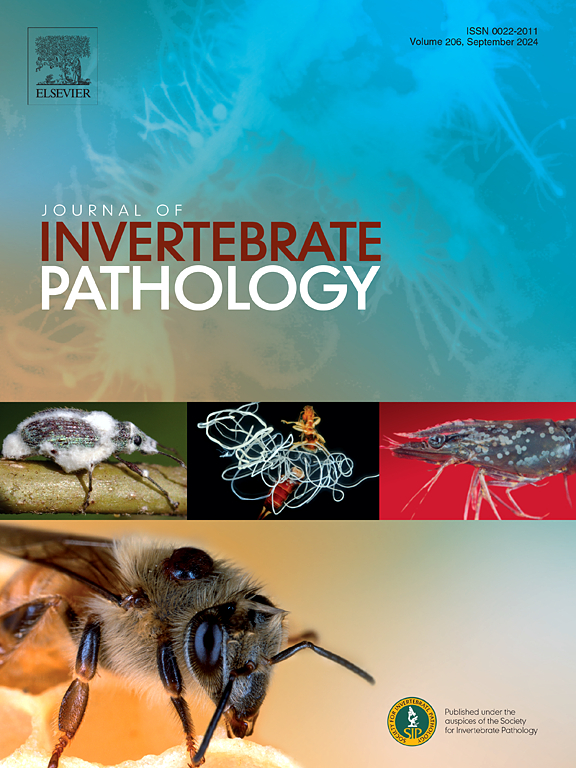Isolation and identification of native Chilean entomopathogenic fungi and their potential for the control of Drosophila suzukii
IF 3.6
3区 生物学
Q1 ZOOLOGY
引用次数: 0
Abstract
Drosophila suzukii is an invasive pest of berries and other soft-skinned fruits, was first detected in Chile in 2017, and has since spread over 2,800 km from north to south. Sustainable control of the spotted-wing drosophila (SWD) is essential due the negative attitude of the consumers toward the excessive use of insecticides. During a survey in Chile for biological control agents, thirty-two isolates of entomopathogenic fungi (EPF) were isolated from mycotized insects and soil samples, identified through sequence analysis, and tested against D. suzukii adults under laboratory conditions. The EPF identified are Akanthomyces muscarius, Beauveria bassiana, Beauveria pseudobassiana, Clonostachys rosea, Metarhizium alvesii, Metarhizium brunneum and Metarhizium robertsii. Six isolates caused 100 % of mortality of D. suzukii adults within ten days after the initial exposition to conidia; these included four B. bassiana isolates (LSB 110, LSB 114, LSB 122 and LSB 125), one M. robertsii isolate (LSB 115) and one M. brunneum isolate (LSB 127). LSB 122 and LSB 125 induced the shortest lethal time (LT50 4 and 4.2 days, respectively), while Akanthomyces and Clonostachys caused ≤ 36 % cumulative mortality of the adults at 10 days of exposure. These results indicate that isolates of B. bassiana, M. robertsii and M. brunneum have significant potential as microbial control agents against D. suzukii adults. This study marks a critical step forward in identifying and validating native entomopathogenic fungi in Chile for sustainable pest management. Future work will focus on further testing these isolates under laboratory, semi-field and field conditions to optimize their application in real-world agricultural settings.

智利本地昆虫病原真菌的分离和鉴定及其控制铃木果蝇的潜力。
斑翅果蝇是浆果和其他软皮水果的入侵害虫,2017 年首次在智利发现,此后从北到南蔓延了 2800 公里。由于消费者对过度使用杀虫剂持消极态度,因此对斑翅果蝇(SWD)的可持续控制至关重要。在智利进行的一项生物控制剂调查中,从霉菌化昆虫和土壤样本中分离出 32 个昆虫病原真菌(EPF)分离物,通过序列分析进行鉴定,并在实验室条件下对苏氏点翅夜蛾成虫进行了测试。鉴定出的 EPF 包括 Akanthomyces muscarius、Beauveria bassiana、Beauveria pseudobassiana、Clonostachys rosea、Metarhizium alvesii、Metarhizium brunneum 和 Metarhizium robertsii。六种分离物在最初接触分生孢子后的十天内导致 D. suzukii 成虫 100%死亡;其中包括四种 B. bassiana 分离物(LSB 110、LSB 114、LSB 122 和 LSB 125)、一种 M. robertsii 分离物(LSB 115)和一种 M. brunneum 分离物(LSB 127)。LSB 122 和 LSB 125 诱导的致死时间最短(LT50 分别为 4 天和 4.2 天),而 Akanthomyces 和 Clonostachys 在暴露 10 天后造成的成虫累积死亡率≤36%。这些结果表明,B. bassiana、M. robertsii和M. brunneum的分离物作为微生物控制剂,对防治D. suzukii成虫具有重大潜力。这项研究标志着智利在鉴定和验证本地昆虫病原真菌以进行可持续害虫管理方面迈出了关键一步。未来的工作重点是在实验室、半田间和田间条件下进一步测试这些分离物,以优化它们在实际农业环境中的应用。
本文章由计算机程序翻译,如有差异,请以英文原文为准。
求助全文
约1分钟内获得全文
求助全文
来源期刊
CiteScore
6.10
自引率
5.90%
发文量
94
审稿时长
1 months
期刊介绍:
The Journal of Invertebrate Pathology presents original research articles and notes on the induction and pathogenesis of diseases of invertebrates, including the suppression of diseases in beneficial species, and the use of diseases in controlling undesirable species. In addition, the journal publishes the results of physiological, morphological, genetic, immunological and ecological studies as related to the etiologic agents of diseases of invertebrates.
The Journal of Invertebrate Pathology is the adopted journal of the Society for Invertebrate Pathology, and is available to SIP members at a special reduced price.

 求助内容:
求助内容: 应助结果提醒方式:
应助结果提醒方式:


